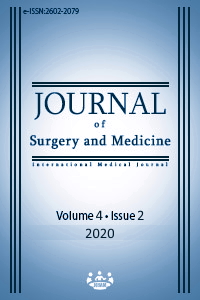Evaluation of postpartum depression scores of elective and emergency cesarean section patients
Keywords:
Cesarean, Emergency, Elective, State-trait anxiety, Postpartum depressionAbstract
Aim: One of the factors affecting postpartum depression is anxiety during pregnancy. This study aims to provide early diagnosis of postpartum depression by investigating the impact of pre-operative anxiety of women, who had an elective or emergency cesarean, on postpartum depression.
Methods: This case-control study was conducted on 103 patients (51 elective, 52 emergency cesarean section cases). Before the surgery, the patients filled State-Trait Anxiety Inventory (STAI) and a form surveying the descriptive properties and obstetric histories. Edinburg Postpartum Depression Scale (EPDS) was applied 6 weeks after delivery. The impact of these results and the anxiety levels in the preoperative period on postoperative depression were analyzed.
Results: The mean value of STAI-1 in the emergency and elective cesarean section groups were 41.31 and 43.61, respectively. Both groups had higher than average (>41) anxiety levels. The mean values of the STAI-2 were equal (48.35) and the anxiety level was above average. As per EPDS, the mean scores of the emergency and elective cesarean section groups were 6.98 and 5.31, respectively. The difference of postpartum rates between two groups was statistically significant (P=0.050). Postpartum depression was observed in 11.53% of the emergency group and 3.92% of the elective group.
Conclusion: Both groups had high state and trait anxiety, however, the postpartum depression rate in emergency patients was higher. It is significant to provide psychological support to the patients with high pre-operative anxiety and early treatment to the ones with a higher tendency of depression in the postpartum period.
Downloads
References
Romano M, Cacciatore A, Giordano R, La Rosa B. Postpartum period: three distinct but continuous phases. J Prenat Med. 2010;4:22-5.
Gingnell M, Toffoletto S, Wikström J, et al. Emotional anticipation after delivery – a longitudinal neuro-imaging study of the postpartum period. Sci Rep. 2017;7:114.
DiFlorio A, Smith S, Jones I. Postpartum psychosis. The Obstetrician & Gynecologist. 2013;15:145–50.
Vander Kruik R, Barreix M, Chou D, Allen T, Say L, Cohen LS. Maternal Morbidity Working Group, The global prevalence of postpartum psychosis: a systematic review. BMC Psychiatry. 2017;28:17-272.
Newport, DJ., Hostetter A, Arnold A, Stowe, ZN. The treatment of postpartum depression: minimizing infant exposures. J. Clin. Psychiatry. 2002;63:31–44.
Degner D. Differentiating between "baby blues," severe depression and psychosis. BMJ. 2017;10;359:j4692.
Hamel C, Lang E, Morissette K, Beck A, Stevens A, Skidmore B, et al. Screening for depression in women during pregnancy or the first year postpartum and in the general adult population: a protocol for two systematic reviews top date a guideline of the Canadian task force on preventive health care. Syst Rev. 2019;19;8:27.
Bayrampour H, McDonald S, Fung T, Tough S. Reliability and validity of three shortened versions of the State Anxiety Inventory scale during the perinatal period. J Psychosom Obstet Gynaecol. 2014;35:101-7.
Fallon V, Halford JCG, Bennett KM, Harrold JA. The postpartum specific anxiety scale: development and preliminary validation. Arch Womens Ment Health. 2016;19:1079-90.
Guillén-Riquelme A, Buela-Casal G. Meta-analysis of group comparison and meta-analysis of reliability generalization of the State Trait Anxiety Inventory Questionnaire (STAI). Rev Esp Salud Publica. 2014; 88:101-12.
Öner N, Lecompte A. Durumluluk-Süreklilik Kaygı Envanteri El Kitabı. 2. baskı İstanbul: Boğaziçi Üniversitesi Matbaası. 1998;2-10.
Cox JL, Holden JM, Sagousky R. Detection of postnatal depression. Development of the 10-item Edinburgh postnatal depression scale. Br J Psychiatr. 1987;150:782-6.
Engindeniz AN, Küey L, Kültür S. Edinburg Doğum Sonrası Depresyon Ölçeği Türkçe Formu geçerlilik ve güvenirlik çalışması. Bahar Sempozyumları. 1997;1(1):51-2.
Özkan H, Üst ZD, Gündoğdu G, Çapık A, Ağapınar Şahin S.The relationship between breast feeding and depression in the early postpartum period. The Medical Bulletin of Şişli Etfal Hospital. 2014;48:124-31.
Jokić-Begić N, Zigić L, Nakić R. Anxiety and anxiety sensitivity as predictors of fear of childbirth: different patterns for nulliparous and parous women .J Psychosom Obstet Gynaecol. 2014;35:22-8.
Alipour Z, Lamyian M, Hajizadeh E, Vafaei MA. The association between antenatal anxiety and fear of childbirth in nulliparous women: a prospective study. Iran J Nurs Midwifery Res. 2011;16:1-6.
Hepp P, Hagenbeck C, Burghardt B, et al. Measuring the course of anxiety in women giving birth by caesarean section: a prospective study. BMC Pregnancy and Childbirth. 2016;18;16:113.
Goldbort J. Transcultural analysis of postpartum depression. MCN Am J Matern Child Nurs. 2006;31:121-6.
Olieman RM, Siemonsma F, Bartens MA, et al. The effect of an elective cesarean section on maternal request on peripartum anxiety and depression in women with childbirth fear: a systematic review. BMC Pregnancy Childbirth. 2017;19;17:195.
Demiröz HP, Taştan K. The effects of perceived social support on postpartum depression. J Surg Med. 2018;2(3):298-302.
Ayvaz S, Hocaoğlu Ç,Tiryaki A, Ak İ Incidence of postpartum depression in Trabzon province and risk factors at gestation. Turk Psikiyatri Derg. 2006;17:243-51.
Hein A, Rauh C, Engel A, Häberle L, Dammer U, Voigt F, et al. Socioeconomic status and depression during and after pregnancy in the franconian maternal health evaluation studies (FRAMES). Arch GynecolObstet. 2014;289:755-63.
Parry BL. Postpartum psychiatric syndromes. In: Kaplan HI, Sadock BJ, eds. Comprehensive textbook of psychiatry , 6th edn, vol 1, Williams & Wilkins, Baltimore, 1995.pp 1059-1066.
Downloads
- 819 1061
Published
Issue
Section
How to Cite
License
Copyright (c) 2020 Berrin Göktuğ Kadıoğlu, Zeynep Kamalak, Gökhan Özpolat, Edip Biçen
This work is licensed under a Creative Commons Attribution-NonCommercial-NoDerivatives 4.0 International License.
















